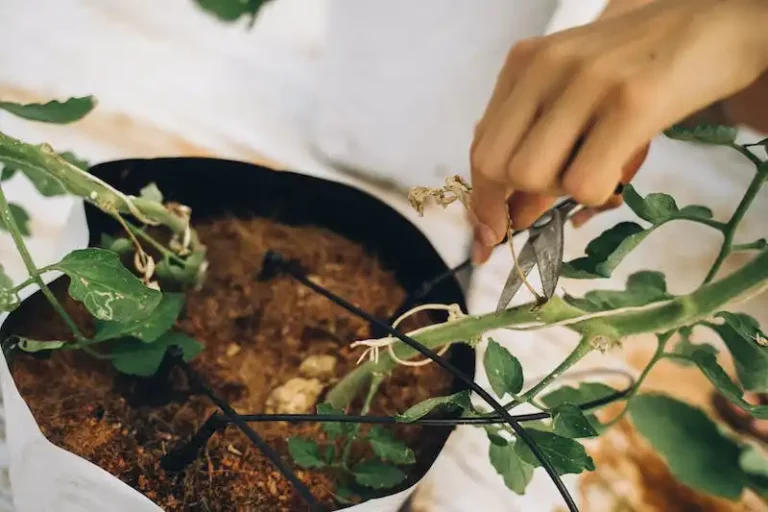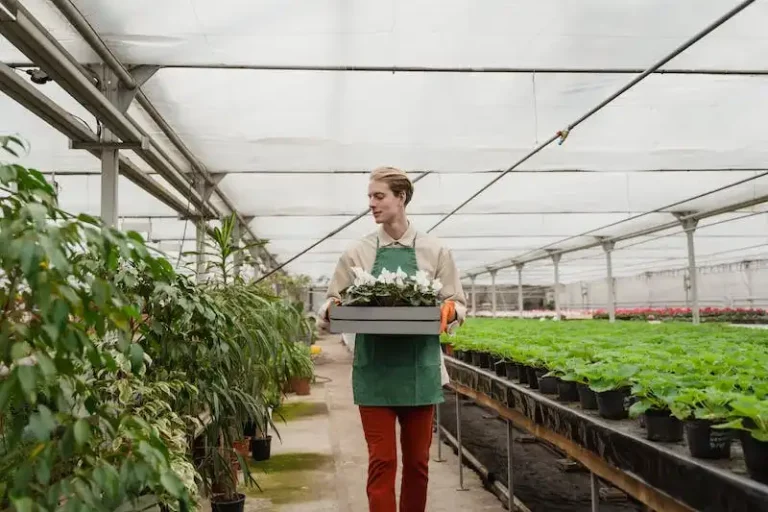When it comes to propagating lavender, there are several methods that horticulture enthusiasts can try. Lavender is a popular plant that has been passed down through time, and many gardeners have found success in propagating it. In this article, we will talk about three methods that you can use to propagate lavender: semi-ripe cuttings, air-layering, and water propagation.
Method 1: Semi-Ripe Cuttings
One of the most common methods for propagating lavender is through semi-ripe cuttings. This method is usually done during the warmer months, when the lavender plant is actively growing. To start, simply find a healthy branch on the lavender plant and remove a 5-6 inch cutting from it. Be sure to remove any lower leaves and dip the cut end in rooting powder. Place the cutting in a pot with a well-draining soil mixture and keep it warm and moist daily. Within a few weeks, roots should start to form, indicating that the cutting has successfully rooted.
Method 2: Air-Layering
Another method for propagating lavender is through air-layering. This method is a bit more advanced and requires some patience. Start by selecting a branch on the lavender plant and remove a small ring of bark, about 1 inch in length. Apply rooting hormone to the exposed area, then wrap it in moist sphagnum moss. Cover the moss with plastic wrap and secure it with a rock or tie. This will create a humid environment for root formation. After a few weeks, roots should start to develop, and you can then remove the rooted branch and plant it in soil.
Method 3: Water Propagation
The third method for propagating lavender is through water propagation. This method is the simplest and requires the least amount of effort. Start by taking a cutting from the lavender plant, about 4-5 inches in length. Remove any lower leaves and place the cutting in a glass of water, making sure the leaves don’t touch the water. Keep the glass in a warm and bright location, changing the water every few days. Within a few weeks, the cutting should start to develop roots, and you can then transfer it to soil.
In conclusion, there are several methods that can be used for propagating lavender. Whether you choose to use semi-ripe cuttings, air-layering, or water propagation, it is important to take the necessary steps to ensure root formation. With a bit of time and patience, you can successfully propagate lavender and grow more of this resilient plant in your garden.
FAQs about Lavender Propagation:
Q: What is the best time to propagate lavender?
A: Lavender can be propagated in the warmer months when the plant is actively growing.
Q: What products do I need in order to propagate lavender?
A: You will need rooting powder, well-draining soil mixture, and sphagnum moss for air-layering.
Q: How long does it take for lavender cuttings to root?
A: It usually takes a few weeks for lavender cuttings to develop roots.
How To Propagate Lavender Plants From Cuttings
Propagating lavender plants from cuttings is a popular and effective method for expanding your lavender garden. It’s a great way to grow more lavender plants that have the same traits and characteristics as the parent plant.
To propagate lavender plants from cuttings, you will need to follow a few simple steps. Here’s a step-by-step guide to help you get started:
- Start by selecting a thick and well-established branch from a healthy lavender plant. Choose a branch that receives plenty of sunlight and has semi-ripe wood.
- Using clean and sharp pruning shears, cut a 4-6 inch long branch from the parent plant. Make sure to take the cutting just above a leaf node, as this is where the roots will develop.
- Remove the lower leaves from the bottom half of the cutting. This will allow the cutting to focus its energy on root development rather than leaf growth.
- Next, dip the cut end of the stem into a rooting hormone. This will help stimulate root growth and increase the chances of successful propagation.
- Prepare a planting container with well-draining soil or a mixture of perlite and vermiculite. Make a small hole in the soil and carefully place the cutting in the hole, making sure that at least 2 inches of the stem is buried.
- Water the cutting thoroughly and place it in a warm and sunny location. Keep the soil moist but not overly saturated, as lavender plants prefer slightly dry conditions.
- It will take some time for the cutting to develop roots. Be patient and check the cutting daily for signs of new growth.
- Once the cutting has rooted, you can separate it from the parent plant and transplant it into a larger pot or directly into the garden. Be gentle when handling the young plant to avoid damaging the delicate roots.
Propagating lavender plants from cuttings is a rewarding and cost-effective way to expand your lavender garden. By following these steps, you can create new lavender plants that possess the same traits and characteristics of the parent plant. Happy propagating!
Lavender Propagation Methods
There are several methods that can be used to propagate lavender plants. Each method utilizes different techniques and tools to successfully create new lavender plants. Here are three common methods:
- 1. Taking Cuttings: This is the most frequently used method for propagating lavender. You will need a sharp knife or pruning shears, a rooting hormone, and some potted soil. Follow these step-by-step instructions to take cuttings from a lavender plant:
- Select a healthy and vigorous young stem from the main growth of the lavender plant.
- Using a knife or pruning shears, snip off a 4-5 inch long piece of the stem, making the cut just below a leaf node.
- Remove any leaves from the lower portion of the stem, leaving a few at the top.
- Dip the cut end of the stem into a rooting hormone to encourage root development.
- Place the stem into a pot filled with well-draining potting soil, burying it about 2 inches deep.
- Water the soil thoroughly and keep it consistently moist until roots have formed.
- Once the roots have developed, you can transplant the new lavender plant to a larger pot or directly into the ground.
- 2. Air-Layering: This method is best done in the warmer months when the lavender plant is actively growing. It involves creating new roots while the stem is still attached to the main plant. Here’s how to air-layer a lavender plant:
- Select a long and flexible stem from a mature lavender plant.
- 3. Seed Propagation: If you have access to lavender seeds, this is another option for propagation. However, it’s important to note that growing lavender from seeds can be a slow and unpredictable process. Here are some tips for successful seed propagation:
- Collect the seeds from mature lavender plants when the seed heads have turned brown and dry.
These methods of lavender propagation can be used to increase your lavender collection or to replenish your existing plants. It’s important to remember that propagation can take some time and patience, but with the right tools and techniques, you can successfully create new lavender plants without having to purchase them from a nursery.
When To Propagate Lavender
In order to successfully propagate lavender, there are a few key steps you should follow. The first step is to choose a healthy, well-established lavender plant. You can either take a cutting from a friend’s plant or purchase a potted lavender plant from a garden center.
The best time to propagate lavender is in the spring or early summer when the plant is actively growing. This is when the stems are most pliable and have the highest chance of rooting successfully. It’s important to wait until the plant has been in the ground or pot for at least a year before taking cuttings to ensure that it has had enough time to establish a strong root system.
When preparing to take a cutting, make sure you have a clean, sharp knife or pruners. You will also need a rooting hormone powder to increase the chances of success. A stick or other source of water will be necessary to moisten the soil during the propagation process.
Once you’ve gathered all of your materials, it’s time to begin the propagation process. The main steps involved in propagating lavender are preparing the cutting, potting the cutting, and providing the right conditions for the cutting to root and grow.
To prepare the cutting, select a young, healthy stem that is approximately 3-4 inches in length. Cut the stem just below a set of leaves using a sharp knife or pruners. Remove any lower leaves or flowers from the stem, leaving only a few sets of leaves at the top.
In order to increase the chances of successful rooting, you can apply a rooting hormone powder to the cut end of the stem. This hormone will help stimulate root growth and increase the chances of the cutting taking root and growing into a new plant.
After preparing the cutting, it’s time to pot it. Fill a small pot with a well-draining potting mix, leaving about half an inch of space at the top. Create a small hole in the center of the potting mix using a stick or your finger.
Place the prepared cutting into the hole, gently firming the potting mix around the stem to hold it in place. Make sure the cutting is planted deep enough that it will remain stable, but not so deep that the leaves will be buried. Water the cutting well, making sure that the potting mix is thoroughly moistened.
Once the cutting has been potted, it’s important to provide the right conditions for it to root and grow. Lavender cuttings root best in warm, humid environments. You can cover the pot and cutting with a clear plastic bag to increase humidity or place it in a greenhouse or other warm, humid location.
It’s important to keep the potting mix consistently damp, but not waterlogged. Water the cutting whenever the top inch of potting mix feels dry to the touch. Avoid over-watering, as this can lead to rotting and the death of the cutting.
With time and proper care, the cutting should begin to root and show signs of new growth. Once the cutting has rooted and the new growth is well-established, you can transplant it into a larger pot or into the garden.
In conclusion, propagating lavender can be a great way to increase your lavender plants. By following these step-by-step instructions, you can learn how to successfully propagate lavender and create new plants to enjoy in your garden.


